Guillotining Rockets: Iron Curtain Active Protection For Light Vehicles
Posted on
Imagine explosive charges so precise they can cut apart an incoming warhead milliseconds before it hits your vehicle. That’s the operating principle for Iron Curtain, an Active Protection System whose computer brain makes 50,000 calculations in the time you take to blink.
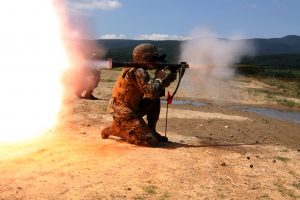
A US Marine fires an RPG in a training exercise with Bulgarian allies
Installed on a frame around the vehicle that looks like a militarized shower rod, the Iron Curtain’s charges propel tiny projectiles straight down like a guillotine. They slice the warhead so precisely that, in 80 percent of tests, it doesn’t even detonate.
Alarmed by rising anti-tank threats, the Army is testing Iron Curtain and two other Active Protection Systems. Each shoots down incoming warheads before they impact in its own way, so each is arguably best suited to a different class of vehicle:
- The only one actually proven in combat is the Israeli Trophy, now being tested on the M1 Abrams heavy tank. (The Russians have battle-tested Active Protection in Ukraine, but the US isn’t buying those systems).
- The Army’s also testing Iron Fist, another Israeli product, on the medium-weight M2 Bradley troop carrier.
- Germany’s Rheinmetall is pitching its Active Defense System, so far unsuccessfully.
- Iron Curtain is being tested on the relatively lightweight Stryker. While the company isn’t speaking publilcly at this stage in the process, I was able to find experts intimately familiar with the system to explain it.
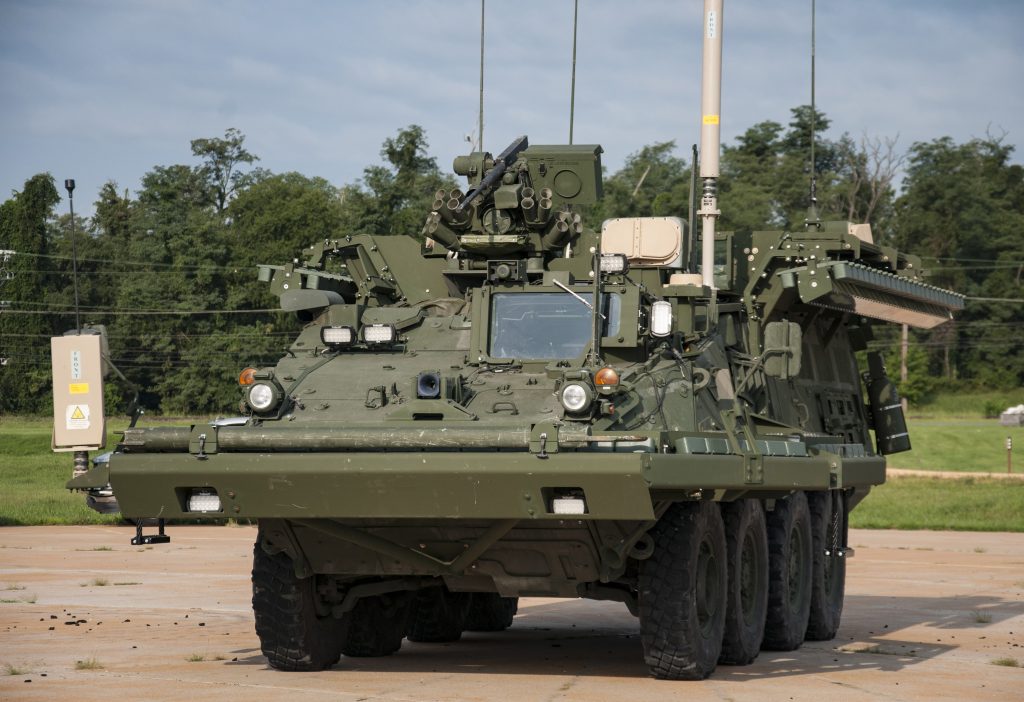
Iron Curtain test installation on a US Army Stryker
Compared to its competitors, Iron Curtain is unique in a couple of ways. First off, it’s the only contender invented in America. Its manufacturer, Artis, is headquartered in Northern Virginia with labs in Utah. Iron Curtain got its start back in 2004 with funding from DARPA and did its first live-fire test later that year.
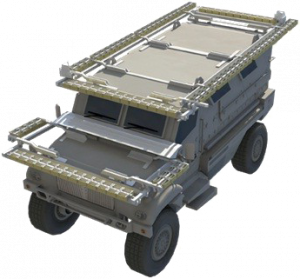
Iron Curtain installation on a light vehicle
At the time, the US military was scrambling to protect its thin-skinned Humvees from roadside bombs and rocket-propelled grenades in Iraq, so Iron Curtain was designed from the start to protect light vehicles. That’s a different task than protecting heavy tanks, one with much less margin for error.
Heavy armor can shrug off shrapnel from a prematurely detonated warhead or backblast from its own defensive charges. (In fact, tanks have long carried Explosive Reactive Armor (ERA), which lies right on top of their regular armor and literally explodes when hit to detonate incoming warheads prematurely). By contrast, a light vehicle’s APS can’t use too big a charge or it’ll blow a hole in the vehicle it’s protecting. It can’t just detonate the incoming warhead prematurely, either, since the blast and fragments might still penetrate the vehicle’s thin armor — or nearby troops on foot.
So Iron Curtain is designed, in effect, not just to destroy the incoming warhead but to disarm it. Each defensive charge contains less explosive than most hand grenades to minimize collateral damage. They make up for their low power with high precision.
Blowing up something to keep it from blowing up may seem paradoxical, but remember modern military-grade explosives are very carefully designed to go off only when their fuse is triggered by the target: Otherwise they’d detonate the first time a 18-year-old grunt dropped his weapon. Anti-tank explosives are particularly finicky: Called “shaped charges,” they detonate in carefully calculated overlapping shockwaves that in turn generate a jet of metal particles moving about six miles per second. An advanced version called an Explosively Formed Projectile (EFP) (similar in concept to the IEDs used so successfully in Iraq) actually forms a solid slug instead of a jet. The hypersonic jet or slug then punches through the target’s armor.
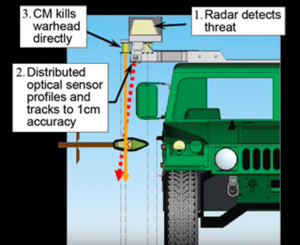
How Iron Curtain works
So Iron Curtain is designed to prevent the jet from forming in the first place. Exactly how is a closely guarded secret, but I did learn that the system’s computer contains a software library of weapons with precisely identified weak points. If the system sees a warhead it doesn’t recognize, it takes its best guess and records the event so human analysts can study it and upgrade the library.
Hitting a specific point on a supersonic projectile requires staggering precision. In a third of a second, the time it takes to blink, Iron Curtain does 50,000 calculations, using specialized chips called Field Programmable Gate Arrays with their algorithms burned into firmware because software is too slow. (Other Artis projects I can’t discuss are even faster). A typical installation uses 3,000 processors distributed all around the vehicle and working in parallel: Each individual defensive charge is controlled by the nearest processors, because relaying sensor data back to a central computer would take too long.
Iron Curtain needs to work so fast because it intercepts the incoming warhead anywhere from a couple of feet away to a couple of inches, so close that milliseconds matter. That sounds pretty hair-raising, but it dramatically reduces the chance that troops or foot or nearby civilians will be caught in the blast.Someone standing just six feet from the detonation would supposedly emerge unharmed.
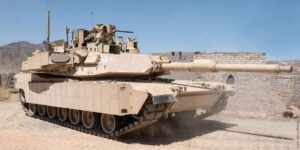
Army M1 Abrams tank with a trial installation of the Israeli-made Trophy Active Protection System (APS)
Because Iron Curtain intercepts at such close range, the radar for the system can be fairly simple. Unlike Trophy, which needs to track the incoming warhead precisely enough to shoot it out of the air, Iron Curtain just needs the radar to warn it something’s coming. The system relies on optical sensors installed around the vehicle to confirm the threat, classify it, and find the right spot to target, all in a fraction of a second. The defensive charges always fire at a fixed angle — usually straight down, but other installations are possible, for example firing upwards to protect a turret — so the only way to aim them at a right point on the warhead is to detonate them at the precise instant that point passes underneath.
Artis claims successful tests on Humvees and M-ATV armored trucks, both relatively light vehicles, as well as on the Army’s cancelled Ground Combat Vehicle program, which was a heavily armored machine. There’s one big gap in this testing history, however. Iron Curtain’s been tested against shoulder-fired rocket propelled grenades (RPGs) but, as far as I could discover, not against anti-tank guided missiles (ATGMs), which are more accurate (being guided) and often larger and faster.
On paper, there’s no reason Iron Curtain couldn’t stop both: For a system that makes 50,000 calculations a second, the difference between an RPG moving 300 meters per second and a Kornet ATGM flying 320 m/s may be pretty trivial. But this is something the Army will have to test with live weapons.
Subscribe to our newsletter
Promotions, new products and sales. Directly to your inbox.
